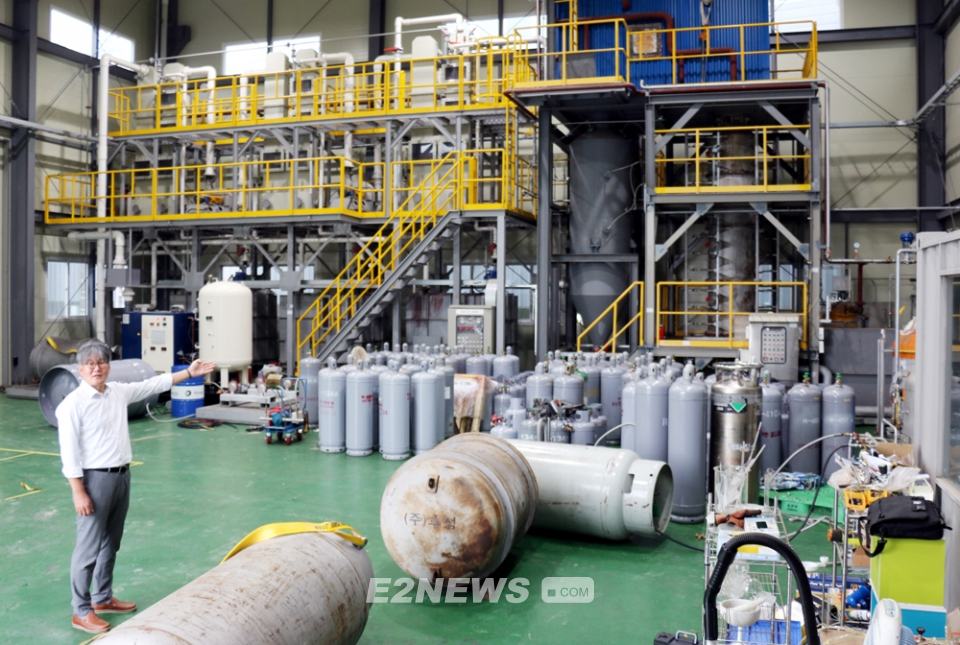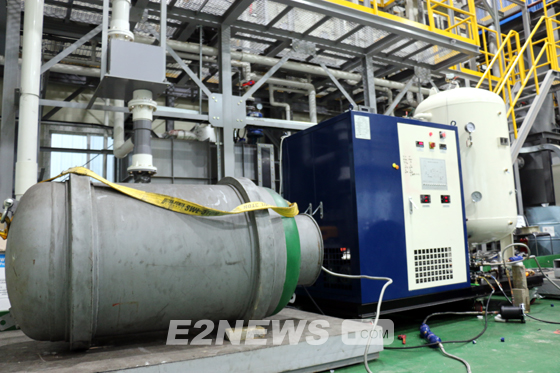[On-site is the answer] "CO2 14,000 times greenhouse gas". Will you leave it there?
Author
admin
Date
2021-12-05 23:44
Views
593
20,000 tons of refrigerant imports per year. It's only 300 tons.
Sunjin environment Co., Ltd., regeneration and destruction of waste refrigerant for the first time in Korea.

▲ Kim Gap-deuk, vice president of Sunjin Environment Co., Ltd. (lower left of the picture), explains its facilities to remove the greenhouse gas burden by thermally destroying non-recyclable refrigerants. Refrigerants are substances that cause up to 14,000 times more warming than carbon dioxide, but they are still poorly managed.
"Every year, 20,000 tons of new refrigerants are imported and used, and only 300 tons are recovered like this. The rest is released into the atmosphere, up to 14,000 times as much as CO의, fueling global warming."
On the 2nd, Saenggok Resource Circulation Complex in Gangseo-gu, Busan. Kim Gap-deuk, vice president of Sunjin environment Co., Ltd., pointed to the refrigerant recovery and purification device connected to the recovered refrigerant container. It is a device that uses different characteristics of liquefaction points for each refrigerant to revive the waste mixed refrigerant with 99% purity regeneration refrigerant. Regenerated refrigerants are put back in charging containers and sold to consumers. It can regenerate up to 1.8 tons a day.
Refrigerant is a chemical that is responsible for heat transfer during cooling and heating, freezing, and refrigerating. There are a large number of low-priced fluorine (CFC, HCFC, and HFC). It is injected into various air conditioners, air conditioners, large buildings, industrial and manufacturing facilities facilities, as well as refrigerators and refrigerators for home and commercial use. It is the refrigerant that is commonly referred to as "air conditioner gas." Colorless and odorless, human toxicity is low.
However, it is fatal to the global environment. When released into the atmosphere, it destroys the ozone layer in the stratosphere and causes global warming, accelerating climate change. In particular, the warming effect of fluorine-based refrigerants ranges from 90 times to 14,000 times less than CO₂. In other words, reusing or completely treating 1 ton of refrigerant is the same as reducing more than 10,000 tons of carbon dioxide.
Sunjin environment Co., Ltd. is a comprehensive recycling venture company that recovers and regenerates or thermally destroys these waste refrigerants. In addition to existing refrigerant regeneration, it uses its own refrigerant thermal destruction facility to dispose of non-recycable refrigerants or impurities during the regeneration process. It is the first time in Korea that a single workplace has obtained both waste refrigerant recycling and destruction permission. You can dispose of 5 tons per day.
Earlier, Sunjin environment Co., Ltd. participated as a company in charge of the Ministry of Environment's "Non-CO2 Greenhouse Gas Reduction Technology Development" national research project to secure 15 patents for original technologies, including thermal destruction and harmless systems of waste refrigerants. At the end of 2017, a dedicated destruction facility was built at the Busan plant. It invested 6 billion won, including R&D expenses. It was at this time that the technology for localization was secured following Japan and the United States.

A refrigerant recovery and purification device connected to a ▲ recovery refrigerant container. It is a recycling facility that restores waste mixed refrigerants to 99% pure recycled refrigerants by using different liquefaction points for each refrigerant.
However, the current facility utilization rate is less than 30% of the processing capacity. This means that all refrigerants that have to be recovered and treated by specialized companies under the Air Environment Conservation Act and the Waste Management Act are being discarded into the atmosphere without anyone knowing at some stage.
The revised Air Conservation Act, which took effect in November last year, requires the owners of refrigerant devices, which are greenhouse gas substances, to record and preserve management matters and submit recovery results every half-year. Building cooling and heating with a daily refrigeration capacity of 20 tons (20RT), food refrigeration and air conditioner, and industrial facilities were first included in the management list. If the user does not comply with his or her obligations, he or she will also be fined 1 million won.
However, laws related to the refrigerant production-use-disposal stage are divided into Montreal's Ozone Layer Protection Act, Electronics Resource Circulation Act, Air Conservation Act, and Waste Management Act, and the crackdown by environmental authorities is virtually neglected due to lack of manpower. The industry estimates that more than 90% of refrigerant imports are in blind spots.
The amount of refrigerant generated in Korea alone is about 30,800 tons per year, and when converted into GWP, it reaches 51.36 million tons of CO 5. Under international agreements, CFCs around the world must reduce new production and consumption to 0% from 2010 and HCFCs from 2030.(HFCs will be reduced by 85% by 2045.
However, compared to the adverse effects of the environment, the refrigerant price is still only three times the price of bottled water, and domestic regulations are so poor that facilities below 20RT are not included in the management list. It is an open secret that most small and medium-sized businesses open valves without consignment of waste refrigerants and release them into the atmosphere without consignment.
Vice President Kim said, "In theory, the amount of refrigerant imports and recovery (renewal or disposal) should be the same, but the actual recovery is only 1 to 2%. It is calculated that 20 times the current facility is needed to recover and dispose of all domestic generations, he said. "If you abide by the law, it will benefit the world, and if you do not, it will not be properly managed even though it is illegal. We need urgent improvement to reduce greenhouse gases and respond to the climate crisis, he said.
Busan = Reporter Lee Sangbok lsb@e2news.com
http://www.e2news.com/news/articleView.html?idxno=215141
Sunjin environment Co., Ltd., regeneration and destruction of waste refrigerant for the first time in Korea.

▲ Kim Gap-deuk, vice president of Sunjin Environment Co., Ltd. (lower left of the picture), explains its facilities to remove the greenhouse gas burden by thermally destroying non-recyclable refrigerants. Refrigerants are substances that cause up to 14,000 times more warming than carbon dioxide, but they are still poorly managed.
"Every year, 20,000 tons of new refrigerants are imported and used, and only 300 tons are recovered like this. The rest is released into the atmosphere, up to 14,000 times as much as CO의, fueling global warming."
On the 2nd, Saenggok Resource Circulation Complex in Gangseo-gu, Busan. Kim Gap-deuk, vice president of Sunjin environment Co., Ltd., pointed to the refrigerant recovery and purification device connected to the recovered refrigerant container. It is a device that uses different characteristics of liquefaction points for each refrigerant to revive the waste mixed refrigerant with 99% purity regeneration refrigerant. Regenerated refrigerants are put back in charging containers and sold to consumers. It can regenerate up to 1.8 tons a day.
Refrigerant is a chemical that is responsible for heat transfer during cooling and heating, freezing, and refrigerating. There are a large number of low-priced fluorine (CFC, HCFC, and HFC). It is injected into various air conditioners, air conditioners, large buildings, industrial and manufacturing facilities facilities, as well as refrigerators and refrigerators for home and commercial use. It is the refrigerant that is commonly referred to as "air conditioner gas." Colorless and odorless, human toxicity is low.
However, it is fatal to the global environment. When released into the atmosphere, it destroys the ozone layer in the stratosphere and causes global warming, accelerating climate change. In particular, the warming effect of fluorine-based refrigerants ranges from 90 times to 14,000 times less than CO₂. In other words, reusing or completely treating 1 ton of refrigerant is the same as reducing more than 10,000 tons of carbon dioxide.
Sunjin environment Co., Ltd. is a comprehensive recycling venture company that recovers and regenerates or thermally destroys these waste refrigerants. In addition to existing refrigerant regeneration, it uses its own refrigerant thermal destruction facility to dispose of non-recycable refrigerants or impurities during the regeneration process. It is the first time in Korea that a single workplace has obtained both waste refrigerant recycling and destruction permission. You can dispose of 5 tons per day.
Earlier, Sunjin environment Co., Ltd. participated as a company in charge of the Ministry of Environment's "Non-CO2 Greenhouse Gas Reduction Technology Development" national research project to secure 15 patents for original technologies, including thermal destruction and harmless systems of waste refrigerants. At the end of 2017, a dedicated destruction facility was built at the Busan plant. It invested 6 billion won, including R&D expenses. It was at this time that the technology for localization was secured following Japan and the United States.

A refrigerant recovery and purification device connected to a ▲ recovery refrigerant container. It is a recycling facility that restores waste mixed refrigerants to 99% pure recycled refrigerants by using different liquefaction points for each refrigerant.
However, the current facility utilization rate is less than 30% of the processing capacity. This means that all refrigerants that have to be recovered and treated by specialized companies under the Air Environment Conservation Act and the Waste Management Act are being discarded into the atmosphere without anyone knowing at some stage.
The revised Air Conservation Act, which took effect in November last year, requires the owners of refrigerant devices, which are greenhouse gas substances, to record and preserve management matters and submit recovery results every half-year. Building cooling and heating with a daily refrigeration capacity of 20 tons (20RT), food refrigeration and air conditioner, and industrial facilities were first included in the management list. If the user does not comply with his or her obligations, he or she will also be fined 1 million won.
However, laws related to the refrigerant production-use-disposal stage are divided into Montreal's Ozone Layer Protection Act, Electronics Resource Circulation Act, Air Conservation Act, and Waste Management Act, and the crackdown by environmental authorities is virtually neglected due to lack of manpower. The industry estimates that more than 90% of refrigerant imports are in blind spots.
The amount of refrigerant generated in Korea alone is about 30,800 tons per year, and when converted into GWP, it reaches 51.36 million tons of CO 5. Under international agreements, CFCs around the world must reduce new production and consumption to 0% from 2010 and HCFCs from 2030.(HFCs will be reduced by 85% by 2045.
However, compared to the adverse effects of the environment, the refrigerant price is still only three times the price of bottled water, and domestic regulations are so poor that facilities below 20RT are not included in the management list. It is an open secret that most small and medium-sized businesses open valves without consignment of waste refrigerants and release them into the atmosphere without consignment.
Vice President Kim said, "In theory, the amount of refrigerant imports and recovery (renewal or disposal) should be the same, but the actual recovery is only 1 to 2%. It is calculated that 20 times the current facility is needed to recover and dispose of all domestic generations, he said. "If you abide by the law, it will benefit the world, and if you do not, it will not be properly managed even though it is illegal. We need urgent improvement to reduce greenhouse gases and respond to the climate crisis, he said.
Busan = Reporter Lee Sangbok lsb@e2news.com
http://www.e2news.com/news/articleView.html?idxno=215141